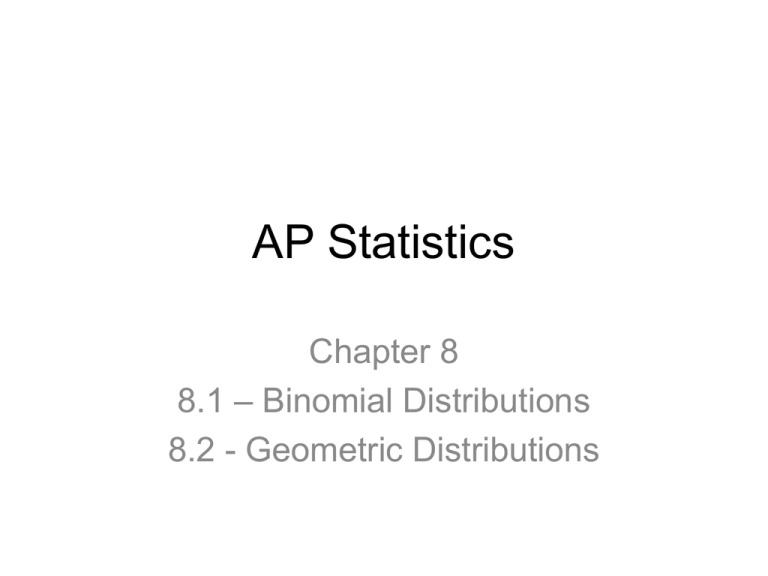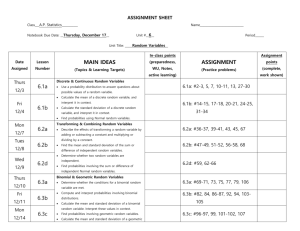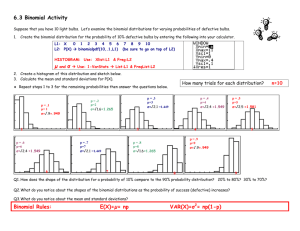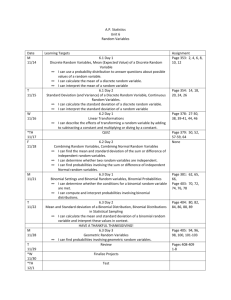Binomial Distribution
advertisement

AP Statistics Chapter 8 8.1 – Binomial Distributions 8.2 - Geometric Distributions The Binomial Setting • There are 16 games a week in an NFL season (if no teams are on a bye week). They flip a coin at each game to decide who gets the ball first. How many “Tails” will you expect? Will this always happen? • If you guess on every question of a 10-question multiple choice quiz, how well do you think you will do? • The previous questions dealt with examples of random occurrences that take place in a binomial setting. Binomial Setting • 1. Each observation falls into one of just two categories (often called “success” and “failure”). • 2. There is a fixed number, n, of observations. • 3. The n observations are all independent. • 4. The probability of “success”, usually called p, is the same for each observation. Binomial Distribution • The distribution of the count, X, of successes in the binomial setting… • B(n, p) – n # of observations – p probability of success on any one observation. Example • In 20 rolls of a die, what is the probability of getting exactly 3 fours? – Why is this problem difficult to answer based on what you have already learned? – Is this a binomial setting? – You can’t simply use the multiplication rule, because the fours could be rolled in any 3 of the 20 rolls. Binomial Coefficient • The number of ways of arranging k successes among n observations can be calculated by… • Read as “n choose k” • In your calculator, n choose k can be found by using the command nCr Finding Binomial Probabilities • X binomial distribution • n # of observations • p prob of success on each observation Binomial probabilities on the calculator • P(X = k) = binompdf (n, p, k) – pdf probability distribution function – Assigns a probability to each value of a discrete random variable, X. • P(X < k) = binomcdf (n, p, k) – cdf cumulative distribution function – for R.V. X, the cdf calculates the sum of the probabilities for 0, 1, 2 … up to k. Mean and Standard Deviation • For a binomial random variable: • When n is large, a binomial distribution can be approximated by a Normal distribution. • We can use a Normal distribution when. – np > 10 and n(1 – p) > 10 • If these conditions are satisfied, then a binomial distribution can be approximated by… The Geometric Setting • 1. Each observation falls into one of two categories (“success or “failure”) • 2. The observations are independent. • 3. The probability of success, p, is the same for all observations. • 4. The variable of interest is the number of trials required to obtain the first success. – We do not have a fixed number of trials – Therefore, the possible values of a geometric random variable are 1, 2, 3, … • It is theoretically an infinite set because we may never observe a “success” Calculating Geometric Probabilities • If X has a geometric distribution with probability p of success and (1 – p) of failure on each observation, the possible values of X are 1, 2, 3, … • If n is any one of these values, the probability that the first success occurs on the nth trial is: Calculating Geometric Probabilities • The probability that it takes more than n trials to the first success is… Mean and Standard Deviation • If X is a geometric random variable with probability of success p on each trial, then the mean (expected value) of the random variable is: • The standard deviation is: Calculator Functions for Ch 8 • Binomial – P(X = k) binompdf(n, p, k) – P(X < k) binomcdf(n, p, k) • Geometric – P(X < n) geometcdf(p, n) • Normal – P(min< X< max) = normalcdf(min, max, μ, σ)








